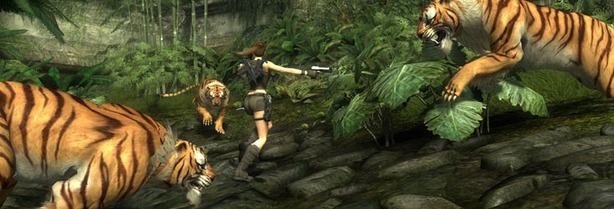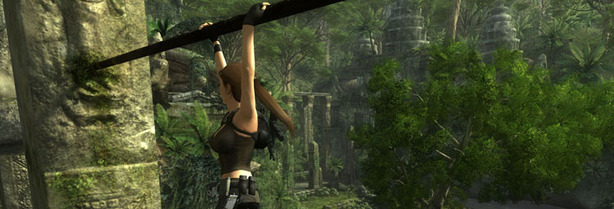
Impressions
The new technology, both in and behind the game, isn’t the only thing to like about Tomb Raider: Underworld though. There are plenty of other new additions and tweaks which are worth a mention.One of our favourite things about Tomb Raider: Underworld is the new focus on puzzles for example. Puzzles are an often-misunderstood element of game design and there are far too many people out there who think that they are irritating, annoying things which serve only to slow down the action.
We feel pity for those people though, as it’s the puzzles in Tomb Raider: Underworld that should be the most celebrated aspect of the game, not the combat.
In fact, the combat mechanics are mostly an improved version of those seen in Tomb Raider: Anniversary – and we don’t think that’s a super good thing, really. That stupid slow-motion targeting idea is still being used, though at least Lara can do some basic hand to hand combat too.
The puzzles in Underworld have taken a step up from any of the previous games, getting both more complex and grand. There’s no more of this ‘I have to climb up there and reposition the three mirrors in order’ nonsense. It’s all got bigger, better and more brain-breaking.
Much of this is down to the multi-tier approach which Crystal Dynamics has employed. Both the puzzles and levels are now a lot more open and less-linear, meaning that the entire structure of the game changes. It’s not just moving forwards through endless corridors to find the next room with a clockwork puzzle in it; it’s a whole lot more complex.
Now, with the open environments, it’s more about searching out and around the temples you’re exploring and finding the right tools to crack the puzzles before you progress. Archaeology is the salvage and study of broken things, so expect to be finding a lot of broken levers and machines that have to be repaired in Tomb Raider: Underworld, often having to search the level thoroughly to find what you need.
Tomb Raider: Underworld is definitely a more convincing and well-thought out world than we’ve ever seen in any of Lara Croft’s previous adventures too. The world is no longer just a blocky mess of ill thought-out plotlines and clichéd one liners. For all its good points, one thing that Anniversary definitely did was show gamers how far the Tomb Raider series had come in terms of narrative.
St. Francis’ Folly, for example, was a great level in Tomb Raider: Anniversary but it really shattered the suspension of disbelief to find this massive underground complex without ivy even growing on walls.
Underworld goes a long way to correct this fault by creating much more interesting, semi-realistic environments. The temples you explore are massive, broken down structures set in hugely inaccessible parts of the world or have been eroded by the footsteps of all those who have gone before you.
There are forgotten mysteries and secrets locked in these places which have remained hidden or overlooked for the longest time. Now, when it is time for these relics and artefacts to start to come to the surface, Lara is going to be there and nothing is going to stand between her and the mystical realm of Avalon that she’s so desperate to break into.
It’s going to be one hell of an adventure.
Tomb Raider: Underworld will be out on all platforms in late November this year and is published by Eidos. It'll also have some Xbox 360 exclusive downloadable content. In the mean time, you can tell us what you think about the game in the forums.

MSI MPG Velox 100R Chassis Review
October 14 2021 | 15:04











Want to comment? Please log in.